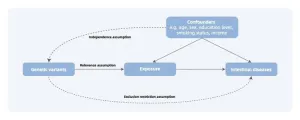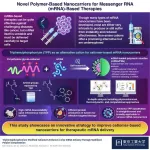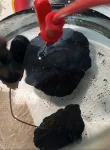(Press-News.org) From your car’s navigation display to the screen you are reading this on, luminescent polymers — a class of flexible materials that contain light-emitting molecules — are used in a variety of today’s electronics. Luminescent polymers stand out for their light-emitting capability, coupled with their remarkable flexibility and stretchability, showcasing vast potential across diverse fields of application.
However, once these electronics reach their end use, they are discarded, piling up in landfills or buried underground. Recycling this electronic waste is complex, requiring expensive and energy-inefficient processes. Although there is an economic incentive to recycle the key semiconducting materials — in this case, luminescent polymers — there has been no method to achieve this due to the challenge of designing those materials at the molecular level.
“We were able to make this material biodegradable and recyclable without sacrificing the functionality.” — Jie Xu, Argonne scientist who led the project
Overcoming this challenge was the motivation behind the newest Nature Sustainability publication led by researchers at the U.S. Department of Energy’s (DOE) Argonne National Laboratory, along with collaborators at the University of Chicago, Purdue University and Yale University. The team developed a strategy to design luminescent polymers with high light-emitting efficiencies from the start that are both biodegradable and recyclable. They do so by incorporating a chemical called tert-butyl ester into the luminescent polymers which can break down when exposed to heat or mild acid.
In short, this chemical enables the recycling of the material while maintaining high light-emitting functions.
The team then used a device to test the material’s external quantum efficiency, an indicator of light source performance. It scored an impressive 15.1% in electroluminescence, a tenfold increase from the existing degradable luminescent polymers.
At the end of life, this new polymer can be degraded under either mild acidic conditions (near the pH of stomach acid) or relatively low heat treatment (> 410 F). The resulting materials can be isolated and remade into new materials for future applications.
“We were able to make this material biodegradable and recyclable without sacrificing the functionality,” said project lead Jie Xu, a scientist in the Center for Nanoscale Materials, a DOE Office of Science user facility at Argonne. “This work serves as an important benchmark in addressing the urgent need for sustainability in the design of future electronics.”
The team aims to make future electronics more sustainable (easier to degrade or recycle) and not just design for current function. They also want to expand the usability of these products into other fields.
“Design is still compatible with processibility and in the end, you have to use this in real applications,” said Yuepeng Zhang, a materials scientist at Argonne and publication co-author. The researchers predict this new polymer can be applied to existing technologies, such as displays and medical imaging, and enable new applications.
Next steps for scaling the technology include moving it from the lab to electronics such as cell phones and computer screens with continued testing.
The team noted this is only a first step in the process, but with electronic waste, every step counts. Xu hopes that more attention will be paid to designing electronics with recyclability in mind, especially since this depolymerization proof of concept was so successful.
“This is a $46 billion-a-year industry, and it is only growing,” said Xu. “By 2032 the industry is estimated to grow to $260 billion. With this method, we can eliminate this type of electronic waste that would otherwise be piling up in landfills.”
Additional Argonne authors include Wei Liu, Aikaterini Vriza, Hyocheol Jung, Shiyu Hu, Benjamin T. Diroll, Richard D. Schaller and Henry Chan. Other authors include Yukun Wu and Sihong Wang (Argonne, Purdue University), Cheng Zhang, Glingna Wang (University of Chicago), Du Chen, Peijun Guo (Yale University) and Jianguo Mei (Purdue University).
Funding was provided by an Argonne Laboratory Directed Research and Development award, the National Science Foundation and U.S. Air Force Office of Scientific Research.
About Argonne’s Center for Nanoscale Materials
The Center for Nanoscale Materials is one of the five DOE Nanoscale Science Research Centers, premier national user facilities for interdisciplinary research at the nanoscale supported by the DOE Office of Science. Together the NSRCs comprise a suite of complementary facilities that provide researchers with state-of-the-art capabilities to fabricate, process, characterize and model nanoscale materials, and constitute the largest infrastructure investment of the National Nanotechnology Initiative. The NSRCs are located at DOE’s Argonne, Brookhaven, Lawrence Berkeley, Oak Ridge, Sandia and Los Alamos National Laboratories. For more information about the DOE NSRCs, please visit https://science.osti.gov/User-Facilities/User-Facilities-at-a-Glance.
Argonne National Laboratory seeks solutions to pressing national problems in science and technology by conducting leading-edge basic and applied research in virtually every scientific discipline. Argonne is managed by UChicago Argonne, LLC for the U.S. Department of Energy’s Office of Science.
The U.S. Department of Energy’s Office of Science is the single largest supporter of basic research in the physical sciences in the United States and is working to address some of the most pressing challenges of our time. For more information, visit https://energy.gov/science.
END
Argonne-led research working toward reducing electronic waste with biodegradable luminescent polymers
The discovery has the potential to reduce electronic waste and develop new applications for luminescent polymers
2024-07-22
ELSE PRESS RELEASES FROM THIS DATE:
B cell biohack: USC engineers immune cells to churn out custom antibodies
2024-07-22
USC scientists have discovered a way to turn the body’s B cells into tiny surveillance machines and antibody factories that can pump out specially designed antibodies to destroy cancer cells or HIV, two of medicine’s most formidable foes.
The research, published today in Nature Biomedical Engineering, describes a technique for editing the genes of immune cells called B cells, turbocharging them to fight even the sneakiest invaders. The work is an important advance in harnessing the power of antibodies to treat conditions ranging from Alzheimer’s ...
Understanding how a red seaweed reduces methane emissions from cows
2024-07-22
Methane is the second-largest contributor to climate warming after carbon dioxide, and so scientists have put a lot of attention toward addressing one of the top sources: methane emissions from livestock. In other words, cow burps are bad for the planet.
Farmers add various seaweeds to cow diets as a source of protein, unsaturated fats, and other health-promoting ingredients that provide immediate energy, says Dipti Pitta of the University of Pennsylvania School of Veterinary Medicine, and a 2016 study in Australia found that feeding sheep a species ...
Genome study informs restoration of American chestnut tree
2024-07-22
Native trees adapt to the climate and environmental conditions of their area to survive. Researchers in the College of Natural Resources and Environment in collaboration with the American Chestnut Foundation confirmed this by examining the genome of American chestnut trees sampled throughout the Appalachian Mountain range and grouping the samples according to their specific environmental region.
The research, recently published in the Proceedings of the National Academy of Sciences journal, has the potential to help the ...
Improved efficacy of pembrolizumab when combined with sEphB4-HSA in HPV-negative EphrinB2-positive HNSCC
2024-07-22
“Future development for sEphB4-HSA in HNSCC is likely to focus on patients with HPV-negative disease where there is greatest need to improve on the outcomes with pembrolizumab monotherapy.”
BUFFALO, NY- July 22, 2024 – A new research paper was published in Oncotarget's Volume 15 on July 10, 2024, entitled, “Improved efficacy of pembrolizumab combined with soluble EphB4-albumin in HPV-negative EphrinB2 positive head neck squamous cell carcinoma.”
Patients with relapsed or metastatic head and neck squamous cell carcinoma (HNSCC) after primary local ...
Sleep and social media in tweens: Tips for better rest
2024-07-22
Toronto, ON - The US Surgeon General recently recommended a warning label for social media platforms due to concerns about their impact on youth mental health. The Surgeon General’s Advisory on Social Media and Youth Mental Health highlighted potential links between social media use and poor sleep quality in youth. Considering these concerns, what specific actions can adolescents and parents take to improve sleep?
A new national study, published in the Journal of Adolescent Health, offers insights into screen habits linked with better sleep.
“Ensuring adolescents get enough sleep is vital, as it supports ...
Effect of cash benefits on health care utilization and health
2024-07-22
About The Study: In this randomized study, individuals who received a cash benefit had significantly fewer emergency department visits, including those related to behavioral health and substance use, fewer admissions to the hospital from the emergency department, and increased use of outpatient subspecialty care. Study results suggest that policies that seek to alleviate poverty by providing income support may have important benefits for health and access to care.
Corresponding Author: To contact the corresponding author, Sumit D. Agarwal, M.D., M.P.H., Ph.D., email sagarwal14@bwh.harvard.edu.
To access the embargoed study: Visit our For The Media ...
Mendelian randomization analysis for intestinal disease: Achievement and future
2024-07-22
Traditional epidemiological studies have identified numerous potential risk factors, but observational studies have struggled to establish causal links due to confounding factors and reverse causation. Theoretically avoiding confounding and reverse causation, Mendelian randomization (MR) infers causality, offering novel research perspectives and methods for investigating risk factors of intestinal diseases (Figure 1).
MR research on intestinal disease
Based on MR methodology, researchers have identified lifestyle factors, circulating nutrients, and obesity as being associated with the risk of ...
Improving the design of mRNA-loaded nanocarriers for targeted therapies
2024-07-22
Among the vastly different ways of tackling a disease, controlling the genetic expression of cells is undoubtedly one of the most powerful. Over the past few decades, scientists have come up with dozens of innovative strategies that involve using messenger RNA (mRNA) to ‘force’ cells to build specific proteins. These mRNA-based therapies have recently gained prominence as vaccines against infectious diseases like COVID-19. Additionally, they hold significant potential for treating cancer and genetic disorders.
Since mRNA itself is ...
Chimpanzees gesture back and forth quickly like in human conversations
2024-07-22
When people are having a conversation, they rapidly take turns speaking and sometimes even interrupt. Now, researchers who have collected the largest ever dataset of chimpanzee “conversations” have found that they communicate back and forth using gestures following the same rapid-fire pattern. The findings are reported on July 22 in the journal Current Biology.
“While human languages are incredibly diverse, a hallmark we all share is that our conversations are structured with fast-paced turns of just 200 milliseconds on average,” ...
Deep-ocean floor produces its own oxygen
2024-07-22
An international team of researchers, including a Northwestern University chemist, has discovered that metallic minerals on the deep-ocean floor produce oxygen — 13,000 feet below the surface.
The surprising discovery challenges long-held assumptions that only photosynthetic organisms, such as plants and algae, generate Earth’s oxygen. But the new finding shows there might be another way. It appears oxygen also can be produced at the seafloor — where no light can penetrate — to support the oxygen-breathing (aerobic) sea life living in complete darkness.
The ...
LAST 30 PRESS RELEASES:
NASA’s Webb telescope finds bizarre atmosphere on a lemon-shaped exoplanet
The gut bacteria that put the brakes on weight gain in mice
Exploring how patients feel about AI transcription
Category ‘6’ tropical cyclone hot spots are growing
Video: Drivers struggle to multitask when using dashboard touch screens, study finds
SLU research shows surge in alcohol-related liver disease driving ‘deaths of despair’
Rising heat reshapes how microbes break down microplastics, new review finds
Roots reveal a hidden carbon pathway in maize plants
Membrane magic: FAMU-FSU researchers repurpose fuel cells membranes for new applications
UN Member States pledge to increase access to diagnosis and inhaled medicines for the 480 million people living with COPD
Combination therapy shows potential to treat pediatric brain cancer ATRT
Study links seabird nesting to shark turf wars in Hawai‘i
Legal sports betting linked to sharp increases in violent crime, study finds
Breakthrough AI from NYUAD speeds up discovery of life-supporting microbes
New Eva Mayr-Stihl Foundation funding initiative boosts research at University of Freiburg on adaptation of forests to global change
The perfect plastic? Plant-based, fully saltwater degradable, zero microplastics
Bias in data may be blocking AI’s potential to combat antibiotic resistance
Article-level metrics would provide more recognition to most researchers than journal-level metrics
Satiety’s little helper: Protein that supports appetite regulating protein identified
UF dives deep into predicting storm damage with computer models
A stormy ocean voyage yields insights on the global carbon cycle
Scientists identify first non-coding gene that controls cell size
Demonstration of altermagnetism in RuO₂ thin films -- A new magnetic material for the AI era
Penn researchers awarded $25M to conduct trial using smartphones to fight heart disease
PCORI awards funding for new patient-centered healthcare research
Exploring the origins of the universe: 145 low-noise amplifiers complete ALMA telescopes
Empress cicada wings help illuminate molecular structure
Using sound waves to detect helium
Time burden in patients with metastatic breast and ovarian cancer from clinic and home demands
Researchers discover bias in AI models that analyze pathology samples
[Press-News.org] Argonne-led research working toward reducing electronic waste with biodegradable luminescent polymersThe discovery has the potential to reduce electronic waste and develop new applications for luminescent polymers






